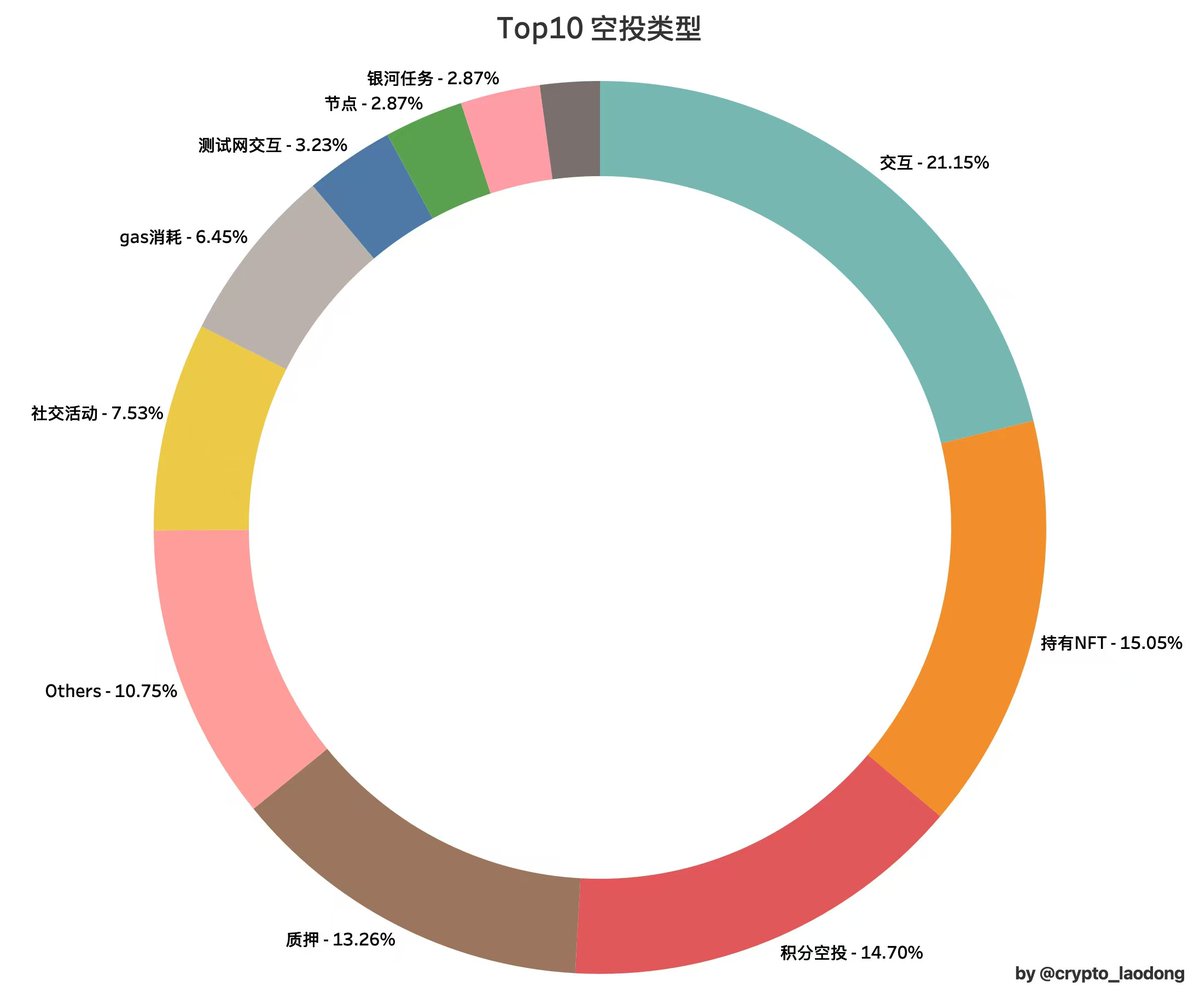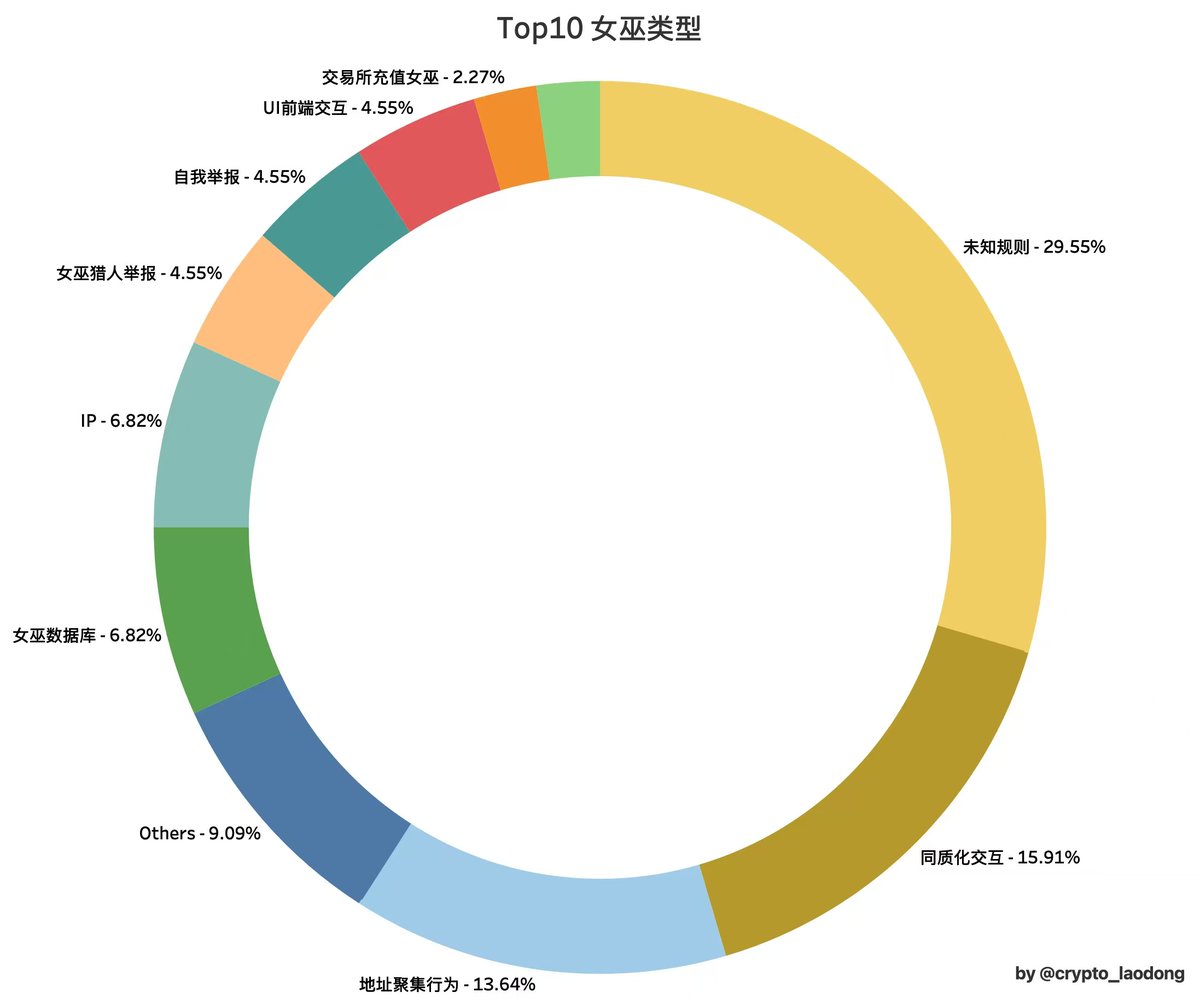Revealing the Latest Trends and Rules of Airdrops: Who is Harvesting? Who is Being Harvested?
Author: 0xLaoDong
2024 Airdrop Data Table:
https://docs.google.com/spreadsheets/d/10l-dsjtrFiFAPBGmUNqwVZSviJ4O0lRypEd4Oc9tCZU/edit?gid=0#gid=0
Preface
The current airdrop market has entered a naked competition for interests. Project parties tacitly allow data fraud to attract financing while simultaneously conducting large-scale cleaning before airdrops; the "hair pulling" crowd is desperately gambling in the dilemma of "if you don't pull, you definitely won't have it; if you do pull, you might not have it." This game without a referee exposes the sharpest contradictions in the airdrop market— the tearing between data bubbles and real value, and the opposition between short-term interests and long-term ecology.
Lao Dong uses airdrop data from 100 projects in 2024 to reveal the latest trends and hidden rules of airdrops—who is harvesting? Who is being harvested?
1. Conflicts of Interest for Project Parties 💡
Core Conflict: Demand for Data Growth (Creating Bubbles) vs Controlling Token Outflow (Eliminating Bubbles)
"We know that over 80% of addresses are studios, but we must rely on them to complete the ecological cold start."
— CTO of a certain L2 protocol
Project parties face a dilemma before the Token Generation Event (TGE):
Left Hand Creating Bubbles: Tolerating studios to batch inflate data, creating on-chain data prosperity (TVL/transaction volume/user count) to attract financing;
Right Hand Cleaning Bubbles: Filtering addresses before airdrops and conducting large-scale cleaning;
- ### Airdrop Type Data Analysis
Lao Dong has organized the airdrop rules of 100 projects in 2024 and summarized the proportion of various airdrop types:

Based on project data analysis, interaction, NFT holding, and points airdrops constitute the three main mechanisms in the current market.
Interaction Airdrops: The most common airdrop method, mainly concentrated on testnets and mainnets, where project parties use a series of tasks, such as Odyssey activities, to increase on-chain interaction data and TVL to attract financing. However, excessive interaction can lead to project parties cleaning addresses. For example, LayerZero had 803,000 addresses deemed as witches, Linea had 40% of addresses deemed as witches, and StarkNet's high-frequency interaction users were marked as bots;
NFT Holding Airdrops: Secondly, NFTs, OATs, etc., often serve as airdrop vouchers, most of which require continuous tasks to obtain or are in the form of whitelists that require funds for minting. These NFTs are usually tradable on-chain, which also creates potential risks of insider trading, making it difficult to identify, and concentrating chips in controllable hands (e.g., FUEL and Berachain's NFTs, with unreasonable airdrop distribution ratios);
Points Airdrops: Currently a mainstream method, unlike tokens, points are centralized data, which are alterable and opaque, and can be infinitely issued, allowing for arbitrary rule adjustments, raising doubts about the fairness of airdrops. For example, ME (points of witch addresses are directly cleared, and exchange ratios differ) and Linea (LXP is an SBT, also a form of points, and tokens may ultimately not receive airdrops). Points airdrops also have serious suspicions of insider trading (EigenLayer's snapshot controversy, Blast's points issuance, and IO's "points shrinkage and theft" controversies all have potential insider trading suspicions);
Other airdrop types such as staking, developer rewards, voting, etc., are also different ways for project parties to filter airdrop recipients. However, the lack of transparency in rules, insider trading, and insider information raises doubts about the fairness of airdrops.
- ### Market Game and Project Party Strategy Choices
The current market is a zero-sum game, with a limited pie that cannot satisfy all interests simultaneously. Project parties cannot meet the interests of themselves, VCs, users, and exchanges at the same time and must distribute interests and extract value in dynamic games. Faced with the contradictions of airdrop incentives, project parties typically adopt two typical strategies:
Sunshine Type: Suitable for small projects or projects with sufficiently generous rewards, such as HYPT, which generally have no filtering, and every address receives rewards. These projects are usually blind pulls, with no clear airdrop rules, making it impossible to determine odds, and difficult to attract a large number of studios;
Strict Filtering Type: Suitable for large projects, usually filtering users through points, interaction frequency, rankings, and witch checks, adopting an elimination system. For example, SCR (only addresses with over 200 points qualify for airdrops), Rune (filtering through holding inscriptions and NFTs), ZKsync and StarkNet (multiple condition filtering), LayerZero (witch reporting system). While these strategies improve the precision of reward distribution, they also increase uncertainty in participation, putting the "hair pulling" crowd at a disadvantage in the rules game;
2. Psychological Conflicts of Participants 🤔
Core Conflict: If You Don't Pull, You Definitely Won't Have It vs If You Pull, You Might Not Have It
Participants also face a dilemma:
If You Don't Pull, You Definitely Won't Have It: If you completely do not participate in the project, you will inevitably miss out on airdrop rewards. To strive for possible gains, many users have to actively participate in various tasks and activities, investing a lot of time and resources, further exacerbating market competition and participant anxiety;
If You Pull, You Might Not Have It: Even with significant investment, it does not guarantee rewards. User input does not correlate with output, as project parties filter addresses through various means. Complex filtering mechanisms lead many participants to lose airdrop eligibility due to strategic errors or being misidentified as witches;
Over-Competition and Investment Risks
Users, in order to compete for limited rewards, must "pull" a large amount of data and activity, but at the same time, the complex and opaque rules and harsh filtering standards make it difficult for participants to predict their actual returns;
Among the 100 projects in 2024, 32 explicitly check for witches. Most project parties' filtering standards are not public, and the review process is a black box, completely controlled by the project parties, leaving users like lambs to the slaughter, subject to arbitrary judgment. The following image analyzes the types of witches:

The core criteria for project parties to filter witches include:
Homogeneous Interactions: A large number of identical operational patterns are the main reason for being deemed witches;
Address Aggregation Behavior: Multiple addresses executing similar operations at the same time and in the same environment are easily recognized and liquidated;
IP, Device, Frontend Interaction: More and more project parties analyze user behavior through frontend data, making simple strategies like changing IP or devices ineffective;
To survive in this airdrop game, relying solely on funds and luck is far from enough; it also requires more refined interaction strategies, stronger technical support, higher counter-surveillance capabilities, and continuous investment and persistence.
3. Conflicts Between Project Parties and the "Hair Pulling" Crowd 🤝
Core Conflict: Mutual Destruction vs Mutual Prosperity
In the game of airdrop incentives, a "symbiotic" relationship has formed between project parties and the "hair pulling" crowd, with their fates closely intertwined:
Mutual Prosperity: When both parties reach a relatively balanced incentive mechanism, it can attract enough active data while ensuring ecological quality, benefiting both project parties and users;
Mutual Destruction: If either party becomes unbalanced, whether due to improper airdrop strategies from project parties or excessive data inflation from the "hair pulling" crowd, it will ultimately have a negative impact on the entire ecology, making it difficult for both sides to thrive independently.
Dynamic Game:
When participating in airdrop activities, project parties usually set certain thresholds. For example, Linea's POH certification and IP entry thresholds. When project parties set relatively lenient participation thresholds, the "hair pulling" crowd can participate in large numbers, leading to a short-term explosion of data. However, once this bubble effect is cleaned by strict filtering mechanisms, the entire ecology may fall into a serious disconnect between data and actual user activity. For instance, after LayerZero announced the completion of snapshots, the number of active on-chain addresses plummeted;
Conversely, when project parties design rules with higher participation thresholds, ensuring that only truly active users who contribute real value can receive rewards, this high threshold may not lead to a short-term surge in participants, but it ensures a healthy and stable growth of active on-chain addresses, avoiding the creation of data bubbles.
The essence of airdrops is the dynamic game of interests between project parties and users. For the "hair pulling" crowd, to steadily secure returns, they must refine strategies, improve interaction quality, and even build long-term value; for project parties, they should not deliberately pursue financing or listing, and the core task should not be how to manipulate users to create short-term prosperity, but how to build a long-term sustainable ecology that truly provides value support.
免责声明:本文章仅代表作者个人观点,不代表本平台的立场和观点。本文章仅供信息分享,不构成对任何人的任何投资建议。用户与作者之间的任何争议,与本平台无关。如网页中刊载的文章或图片涉及侵权,请提供相关的权利证明和身份证明发送邮件到support@aicoin.com,本平台相关工作人员将会进行核查。



